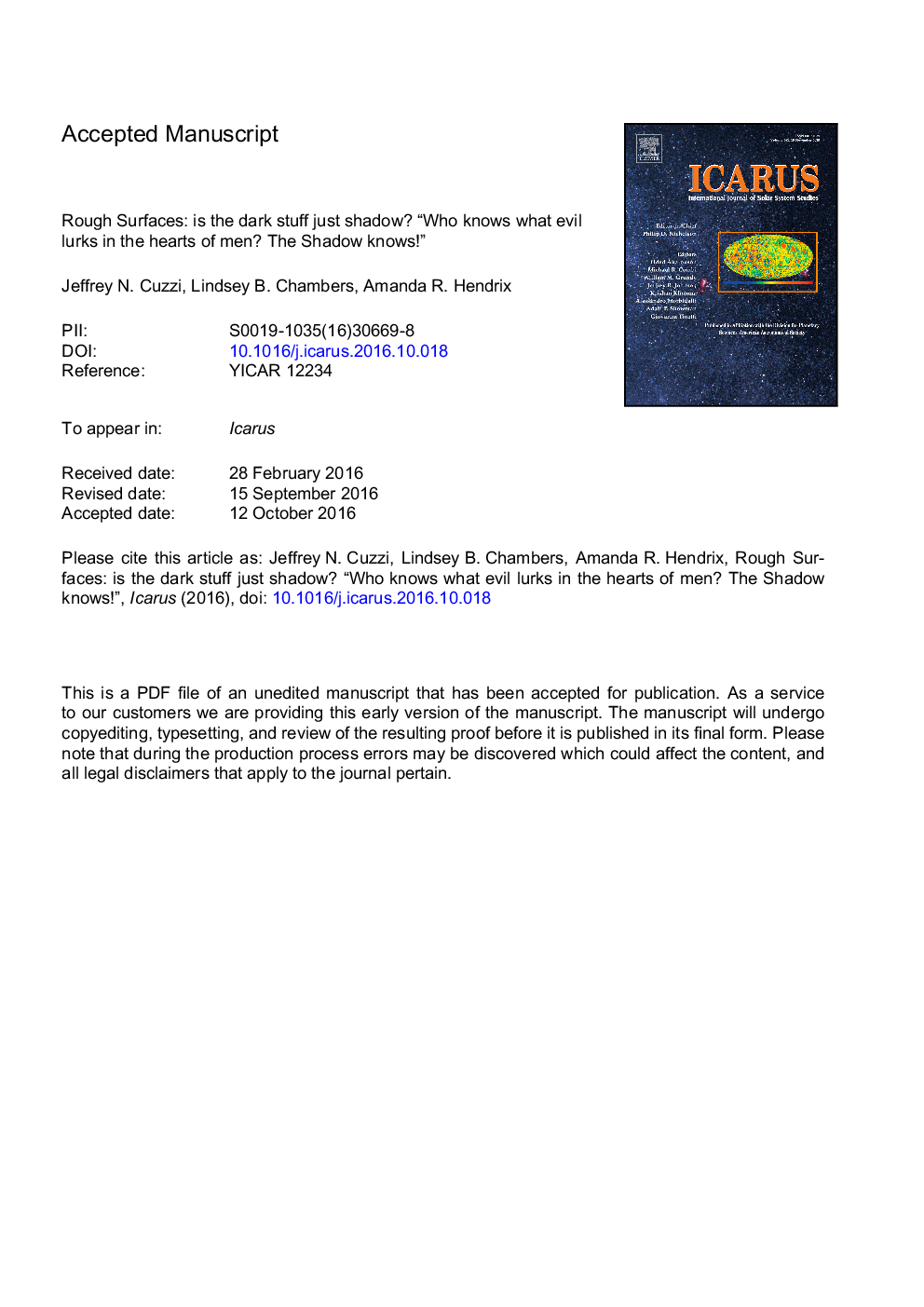| کد مقاله | کد نشریه | سال انتشار | مقاله انگلیسی | نسخه تمام متن |
|---|---|---|---|---|
| 5487295 | 1523502 | 2017 | 30 صفحه PDF | دانلود رایگان |
عنوان انگلیسی مقاله ISI
Rough surfaces: Is the dark stuff just shadow?
ترجمه فارسی عنوان
سطوح خشن: آیا مواد تاریک فقط سایه است؟
دانلود مقاله + سفارش ترجمه
دانلود مقاله ISI انگلیسی
رایگان برای ایرانیان
کلمات کلیدی
ترجمه چکیده
مشاهدات از راه دور از سطوح از اجسام سیاره بدون هوا، برای تعیین ساختار فیزیکی و آرایش ترکیب مواد سطح، اساسی هستند. تعدادی از مدل های پیش رو برای تکثیر رفتار فوتومتریک این سطوح براساس خواص ساختاری خاصی نظیر زبری مکروسکوپی و سایه زنی همراه شده است. اکثر کارهای این نوع به آلبد های هندسی اعمال می شود که تحت تأثیرات پیچیده نزدیک زاویه فاز صفر قرار می گیرند که فقط یک بخش کوچکی از انرژی خالص منعکس کننده جسم را نشان می دهند. برنامه های کاربردی دیگر عبارتند از: پارامتر متناسب با بخش های حل شده از برخی از سطح سیاره ای که در طول طیف وسیعی از هندسه ها دیده می شود. آلبدو کروی کل شی (زمانی که می توان آن را تعیین کرد) تعادل انرژی خالص ذرات را قوی تر از آلبدوم هندسی جذب می کند. در بسیاری از درمان های آلبید کروی، آلبد های کروی و توابع فاز ذرات اغلب به عنوان اگر آنها مستقل هستند، غفلت از اثرات زبری. در این مقاله رویکردی متفاوت داریم. ما یادآوری می کنیم که هر تابع ضریب وابستگی زاویه فاز روشنایی یک عنصر واقع در سطح خشن، سایه ای، سطح مسطح نسبت به سطح دانه صاف همان ماده است، به طور مستقیم در هر دو عملکرد فاز انتگرال و آلبدو کروی از جسم ما پیشنهاد می کنیم که در صورتی که زاویه پوشش فاز گسترده ای امکان پذیر باشد، آلبد های کروی را می توان به راحتی برای اثرات سایه زنی با استفاده از توابع فاز مشاهده شده (یا فرض شده) تصحیح کرد و سپس با استفاده از مدل های انتقال تابشی رگولیت صاف سطح بدون اعمال بیشتر تصحیح شده است. ویژگیهای رویکرد ما "قدرتلاوا" را مشاهده کردید؟ توابع فاز شیب های مختلف (و خطی از زاویه فاز در مقیاس بزرگ) به سایه انداختن، همانطور که دیگران است، و پیشنهاد می شود که نتیجه گیری های مبتنی بر مدل رگولیت بر اساس کروی ناپایدار سایه آلبوم ها مقدار مواد جذب شده موجود در رگولیت را بیش از حد ارزشمند می دانند.
موضوعات مرتبط
مهندسی و علوم پایه
علوم زمین و سیارات
علوم فضا و نجوم
چکیده انگلیسی
Remote observations of the surfaces of airless planetary objects are fundamental to inferring the physical structure and compositional makeup of the surface material. A number of forward models have been developed to reproduce the photometric behavior of these surfaces, based on specific, assumed structural properties such as macroscopic roughness and associated shadowing. Most work of this type is applied to geometric albedos, which are affected by complicated effects near zero phase angle that represent only a tiny fraction of the net energy reflected by the object. Other applications include parameter fits to resolved portions of some planetary surface as viewed over a range of geometries. The spherical albedo of the entire object (when it can be determined) captures the net energy balance of the particle more robustly than the geometric albedo. In most treatments involving spherical albedos, spherical albedos and particle phase functions are often treated as if they are independent, neglecting the effects of roughness. In this paper we take a different approach. We note that whatever function captures the phase angle dependence of the brightness of a realistic rough, shadowed, flat surface element relative to that of a smooth granular surface of the same material, it is manifested directly in both the integral phase function and the spherical albedo of the object. We suggest that, where broad phase angle coverage is possible, spherical albedos may be easily corrected for the effects of shadowing using observed (or assumed) phase functions, and then modeled more robustly using smooth-surface regolith radiative transfer models without further imposed (forward-modeled) shadowing corrections. Our approach attributes observed “powerlaw” phase functions of various slope (and “linear” ranges of magnitude-vs.-phase angle) to shadowing, as have others, and goes in to suggest that regolith-model-based inferences of composition based on shadow-uncorrected spherical albedos overestimate the amount of absorbing material contained in the regolith.
ناشر
Database: Elsevier - ScienceDirect (ساینس دایرکت)
Journal: Icarus - Volume 289, June 2017, Pages 281-294
Journal: Icarus - Volume 289, June 2017, Pages 281-294
نویسندگان
Jeffrey N. Cuzzi, Lindsey B. Chambers, Amanda R. Hendrix,
